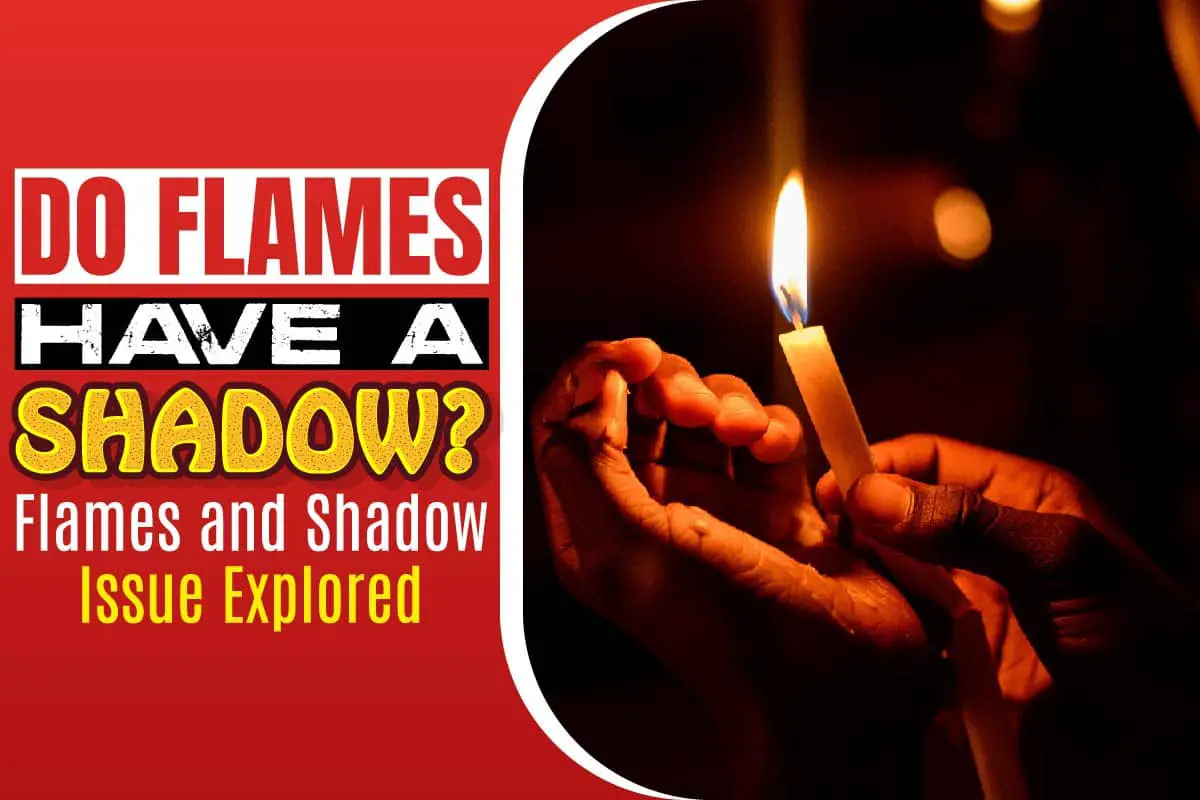A shadow is described as a dark area or shape produced by an obstacle between rays of light and a surface. Fire creators can use shadows literarily in specific ways. For instance, it can be used to reference oppressiveness or a sad state of gloom or sadness. An opaque object has to come in between a light source and a surface for a physical shadow to occur. While some objects or light sources can’t create a shadow, their products can block light rays and create temporary shadows on a surface.
So, Do Flames Have a Shadow?
No, but the hot hair and soot created by flames or fire can create shadows on a surface due to their opaqueness and ability to deflect the light beam.
Is It Possible To Create Shadow From Fire Or Flame?
Though flames from fire naturally don’t produce shadows, a shadow may be created when any part of the projected light beam is redirected or blocked.
The shadow region is often the region where there is less light than the rest of the beam. The dimer area of the beam will take the shape of the opaque object, blocking or redirecting it. For this reason, we tend to think that a shadow is caused by something that is intercepting or casting light. For the fire to create a shadow, it must block or redirect the path of another beam of light.
The traditional flame from a fire can redirect or block light because it is not just a pillar of light. The flame contains several different hydrocarbon components, including fuel and Oxygen molecules burnt by the fire. Burning flames releases soot and many other impurities, carbon dioxide, and water vapor into the air.
How Flames Create Shadow
Solid impurities from flames that go into the air during burning can glow in a process called Incandescence. The boundary between the hot air and the flame alongside the surrounding colder air may bend light away from its forward-propelling movement. Refraction will occur at the interface of deflection between different materials – this is the same effect that allows a camera lens to focus light.
The fact that a flame contains hot air and some impurities makes it deflect light within a light beam to create its own shadow.
Hot air rises typically turbulently; that is why the shadows created by soot and other materials from the flame will look like dancing ripples. The soot inside the flame can absorb some light and contribute significantly to the creation of shadow.
To notice the shadow created by fire, the light beam going past the fire must at least be as bright as the light produced by the fire. If the light passing by the flame or fire is not as bright as the fire, the light spreading out in all directions from the fire will overpower the dim region of the incident light passing by.
For instance, pointing a weak flashlight at a fire in the night will not create a shadow from the fire. On the other hand, a brighter light beam like sunlight with a fire releasing lots of soot and heat will create a striking shadow.
Why Fire Can Have A Shadow
Remember that fire or flame can create a shadow, not because of the incoming beam of light that will be deflected, but because it releases opaque substances and can create a shadow.
Fundamentally, a single beam of light is incapable of interacting directly with another beam of light. This explanation means that light beams will never bounce off each other, nor will they absorb or deflect each other. The reason for this is that light comprises particles referred to as photons that are bosons in nature.
Bosons are known to overlap and even pass through each other or occupy the same state at the exact location. Since photons don’t carry electric or magnetic charges, they can overlap and occupy the same state.
The electromagnetic fields, including those constituting light, will only interact with objects that carry electric or magnetic charges. When there are no electric or magnetic charges to interact with one light beam will be incapable of influencing another light beam in any way. With zero magnetic and electric field, one light cannot directly or indirectly affect the path or activity of another light.
In another situation, one light beam can deflect another light beam indirectly when you change the material through which the light beams travel. The bottom line is that fires can create shadow not because of their light but because of the impurities they release into the atmosphere when they burn and create flames.
Facts You May Not Know About Fire And Flame
Since you cannot create a flame without fire, it is essential to be aware of the properties of fire to understand flame. The following are features of fire, and some can be very interesting;
1. Fire is a Rapid Oxidation of a Material
Without oxidation, you cant produce any fire. Fire can therefore be regarded as an exothermic combustion process with the final release of heat, light, and impurities like soot.
Fire feels hot because of the conversion of the double-bond within the molecular Oxygen merged with the stronger bonds in the material being burnt. Flames are eventually produced at the ignition point of the combustion process.
2. Flame Comprises of Carbon Dioxide, Water vapor, Oxygen, and Nitrogen.
Flame, a direct product of the ignition of the bonds involved in making fire, comprises carbon dioxide, water vapor, Oxygen, and Nitrogen. The combustion effect of bonds creating fire causes the release of Carbon dioxide, heat, and Oxygen when a flame is also created.
When a flame is hot enough, the gases become ionized to create Plasma. Depending on the substance being set on fire and the impurities within, the color of a flame and fire intensity can vary.
3. Fire Has some Positive Effects
People can hardly associate any positive thing to fire, but in the real sense, fire can stimulate growth and helps in maintaining ecological systems. Fire has too many devastating adverse effects though, it creates severe hazards to lives and properties and can also trigger atmospheric pollution.
If a fire damages the vegetation, it can lead to flooding if there is heavy rain, increasing the risks of soil erosion. Similarly, when plant vegetations are burnt, Nitrogen substances are released into the atmosphere- this, in the long term, may lead to a significant reduction in the soil’s fertility.
Planting leguminous plants and lightning are some of the ways through which It is possible to reverse the soil’s depleted Nitrogen levels.
Fire has many other positive effects; for instance, in agriculture, fire has been used to clear land. Fire is also used in the generation of heat for light and heat in cooking. In dangerous situations, fire can be generated to create emergency awareness and for propulsion purposes. Waste incineration, smelting, forging, and even cremation of animals and humans remains are other positive uses of fire.
4. Fire’s Chain Reaction Must be Sustained
To maintain heat balance or sustain the heat generated by fire, there must be a chain reaction, primarily through continuous fuel and oxygen supply. Oxygen, for instance, will remove combustion products quickly to give way to new heat from fire. Turning on the gas supply, covering the flame entirely, and applying water can lead to quick removal of heat, eventually killing the fire itself.
5. Flame is a Mixture of Reacting Gases
A mixture of gases and solids emitting flammable infrared and ultraviolet light is referred to as a “Flame”. The type of flame given off will largely depend on the components of the burning substance. The frequency of the spectrum of the flame will also depend on the components of the burning substance.
Incandescent solid particles for instance will produce an orange-yellow glow which also comprises of a stable and continuous spectrum.
The distribution of flame under the normal gravity and other conditions will depend on convection Soot in particular will rise to the top of the flame, thus creating a yellow glow. Flame can become spherical when gravity does not exist and will likely turn blue and more efficient.
6. Fire and Flame Can be Controlled in Many Ways
From early humans to modern technology, fire can be controlled for different applications. The early humans control fire to generate heat and make it easier to cook food. The modern-day aeronautic engineers use technology to control fire in propelling aircrafts to space. Fire is also controlled in the electrical, plumbing, sports, and manufacturing sectors to achieve different purposes. The control over fire gives us the chance to create different tools and devices we can use in different ways.
You May Like These Articles As Well:
Is Grey A Color Or Shade? Differentiating Between Colors And Shades
Are Black And Milds Worse Than Cigarettes? Vital Info For Smokers
 Being Human
Being Human




